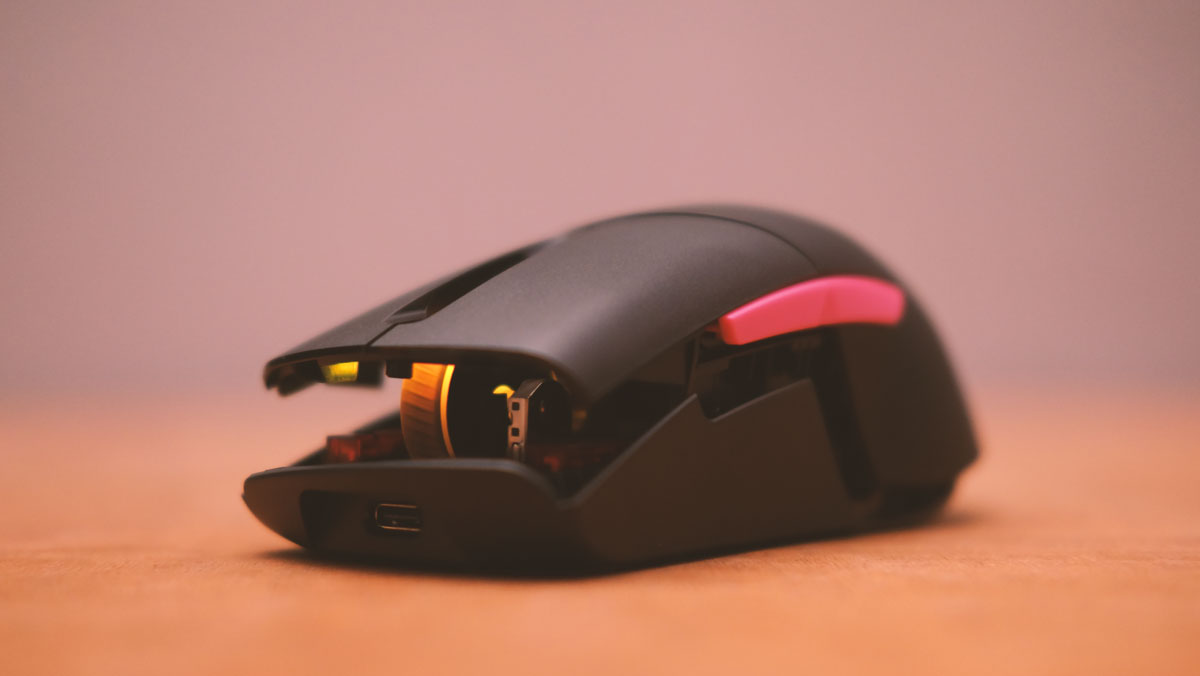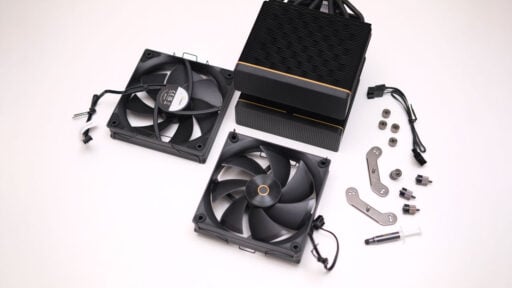ASUS ROG is back with another gaming mouse for Q1 of 2021 in the form of the Keris Wireless. This one is a highly anticipated model since announcement – mainly due to a variety of good reasons.
For an instance, its curb weight is about 79 grams – all thanks to the materials used and a new shell design. This mouse also comes with triple connectivity options, an ROG exclusive push-fit switch socket, ASUS’ own switches and PBT housings for the main buttons – among many others. The model is also available in wired version which is even lighter at 63 grams.
On this review, we will check out how the 4,690 Pesos MSRP wireless device will fair against the competition. See if it is worthy of that price tag.
Table of Contents:
- 1 Technical Specifications
- 2 Packaging and Accessories
- 3 Design, Layout and Build Quality
- 4 Test Setup and Methodology
- 5 Physical Layout, Functionality and Ergonomics
- 6 DPI Range and Accuracy
- 7 Polling Rate Range and Performance
- 8 Sensor Quality and Performance
- 9 Software, Lighting and Special Features
- 10 Final Thoughts
Technical Specifications
| Mouse | |
| Size | Medium |
| Layout | Right handed |
| Design | Standard |
| Macro | Yes |
| Profile | Yes |
| Software | Yes |
| Interface | RF 2.4GHz, Bluetooth, USB 2.0 |
| Polling Rate | 125-1000Hz |
| Lighting | RGB |
| Switch | ROG Micro, Omron D2F-01F |
| Buttons | 8 (5 programmable) |
| Cable Length | 2m (paracord) |
| Feet | PTFE |
| Sensor | |
| Model | Pixart PAW3335 |
| DPI | 100-16000 DPI |
| Speed | 400IPS/40G |
| Dimensions | |
| Length | 118mm |
| Width | 62mm (Max), 55mm (Grip) |
| Height | 39mm |
| Weight | 79g |
Packaging and Accessories
The ROG Keris Wireless is packed similar to other ASUS gaming mice in recent times. The following items should be located inside:
- ROG Keris wireless gaming mouse
- Wireless RF 2.4GHz Dongle
- USB Type-C Cable (paracord)
- User Guide
- Warranty card
- 2x Spare side buttons
- Mouse feet sheet
- 2x Omron 1M micro switch
Bundle is absolutely nice. We even got a set of extra skates, buttons and switches.
Design, Layout and Build Quality
The ASUS ROG Keris comes with a slender and curvy profile – similar to the Microsoft Intellimouse design. This is a proper looking gaming mouse, devoid of any clutter out of the box. Weighs like a feather too at ~79 grams. Note: the wired versions comes with an even lighter curb weight of 62 grams.
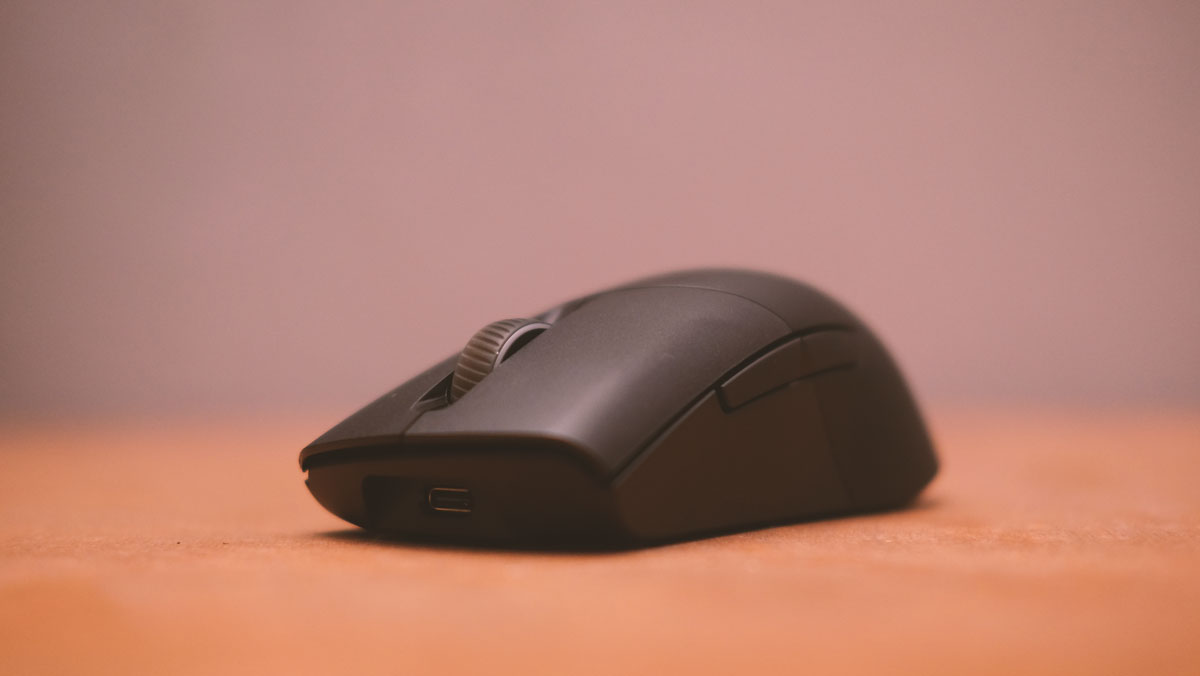
There are 8 buttons found within the mouse and 5 of them are fully customizable – with the exception of the DPI, pairing and main left button. This is no biggie since the mouse is not ambidextrous and ASUS felt a non-customizable main button could acts as a safety net. Left and right main buttons have really low pre-travel (ROG Zero Gap) and are snappy. Left navigation buttons on the other hand has a bit of pre-travel (Kaihl switches). The scroll button on the other hand requires more force to actuate compared to the others.
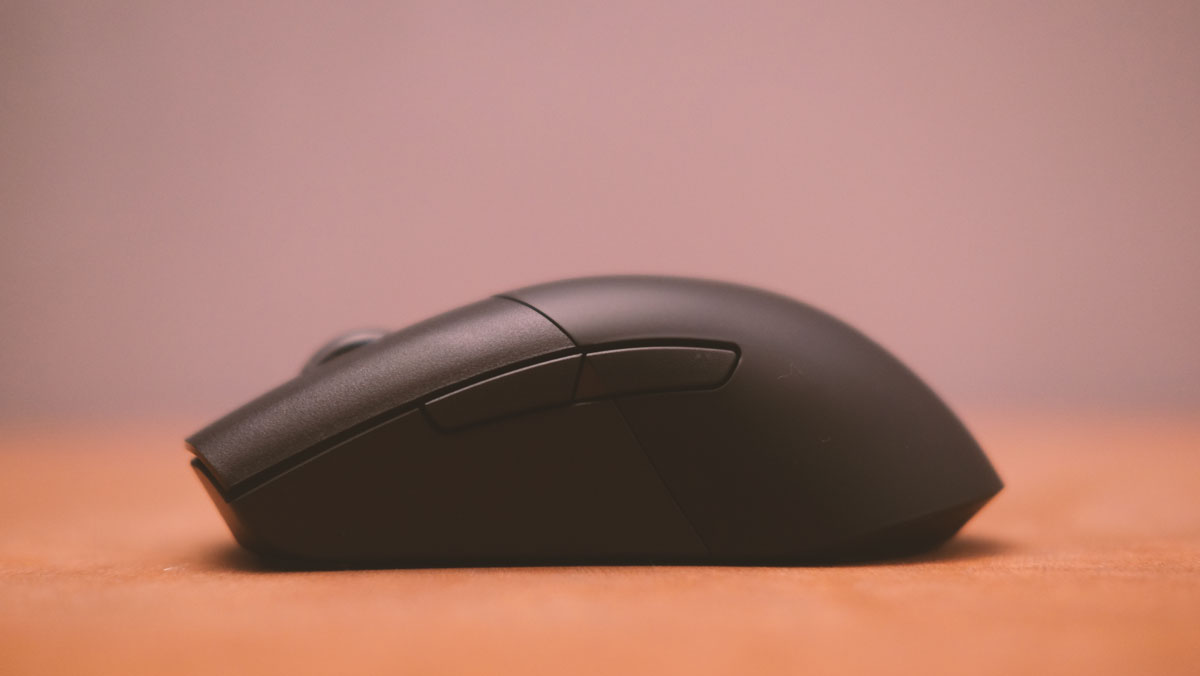
The grip area has two different textures – the usual textured plastic and matte. Both sides are curved inward from the grip area with a gradual outward curvature towards the rear end.
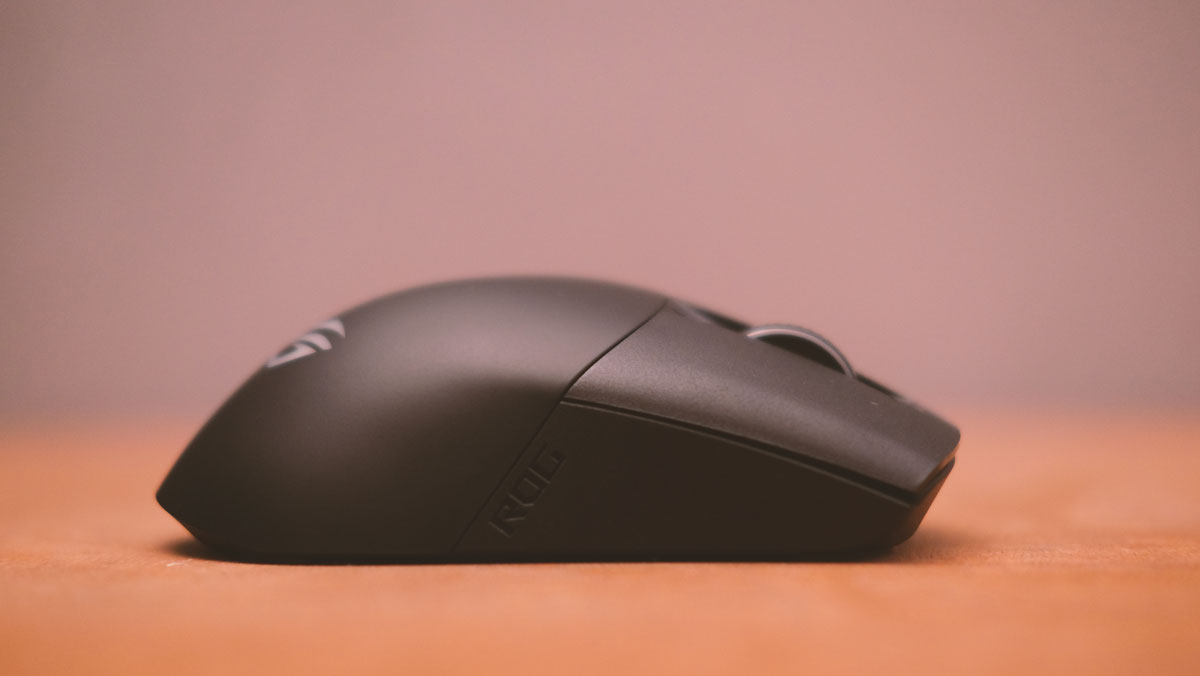
Now ASUS changed their usual formula for the main buttons with this new model. For instance, PBT is now the material of choice to maximize grip and to prevent shine. The not so favorable Pivoted Button from the Strix Impact II has been overhauled for the Keris as well – and with an additional guide per buttons to keep the platforms stable. Now as for the scroll wheel, it is a detent based one. No infinity scroll support here – yet.
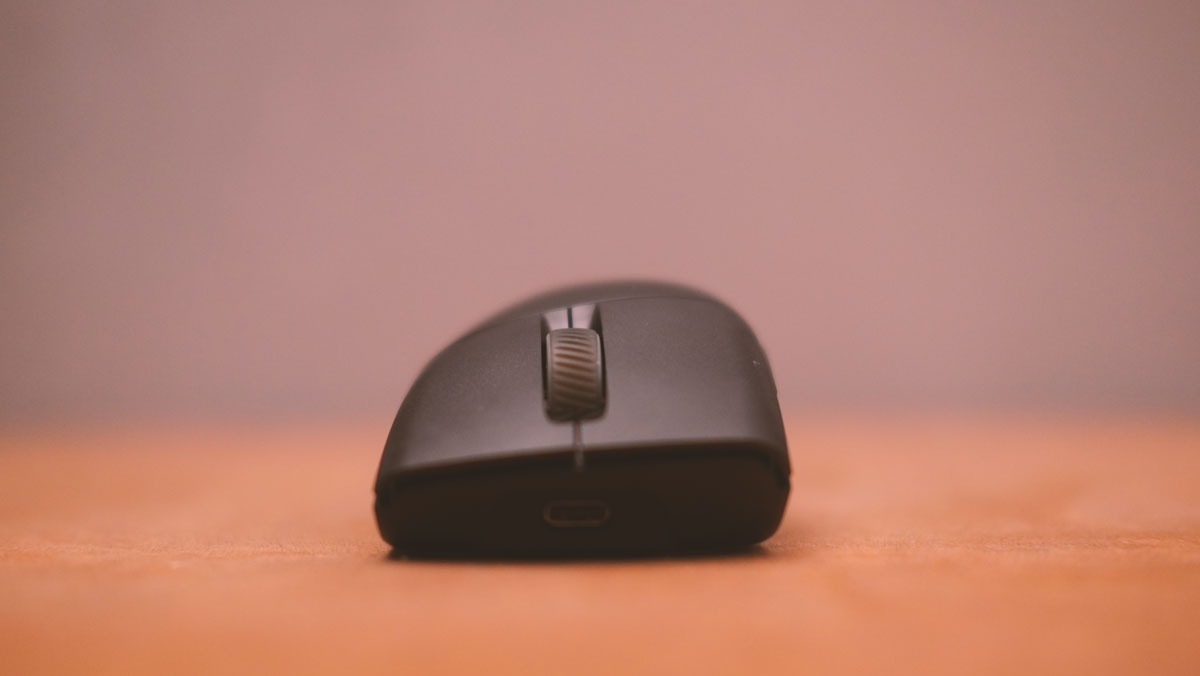
Another thing I love about the mouse are the proprietary yet easy to replicate skates. ASUS even managed to sneak a set just in case. Along this area lies the PTFE shielded PAW3335 sensor. the DPI, BT pairing button, the switch and the dongle housing.
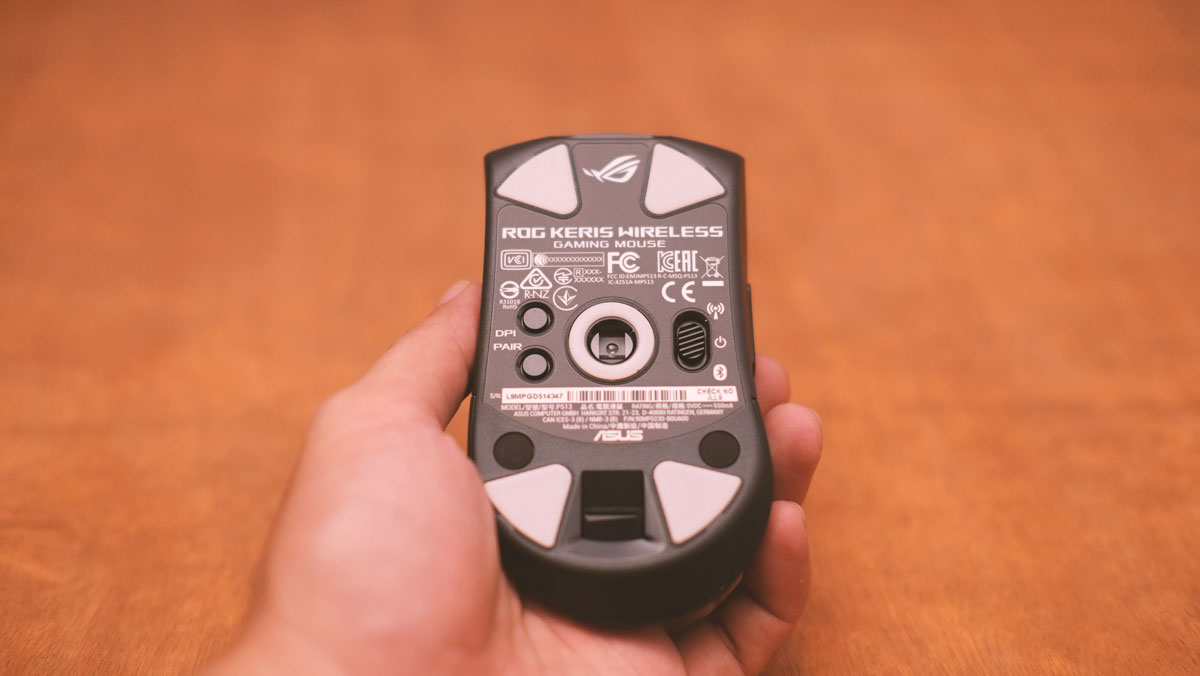
It is also worthy to note that the Keris comes with a 2 meter paracord data cable – that’s for both the wired and wireless version. It is also much more manageable compared to the stiffer implementation of the Fantech XD3. This mouse doesn’t make any noise when griped really hard, shell doesn’t even flex and mechanical parts are definitely wobble free.
Test Setup and Methodology
Testing a gaming mouse is not that difficult, but it is mostly subjective; similar to testing head gears in a sense. That said, no mouse is perfect and the verdict usually depends on personal preferences. With that in mind, we overhauled our testing methodology by following key pointers that should matter the most. To keep our test methodology simple and free of extra variables, please note the following software and configurations used for the review.
| Test Setup | |
| Pointer Speed | 6/11, EPP Disabled |
| Sensitivity | 800 DPI |
| Polling Rate | 1000Hz |
| Software | MouseTester V1.5.3 |
Physical Layout, Functionality and Ergonomics
Your grip and aiming style are important things to consider when looking for a mouse. There are three basic types of grips here; the palm, claw and fingertip grip. Fingertip grip is generally preferred when aiming with the wrist, while palm grip is the choice when aiming with the arm. Claw grip is middle ground options for both aiming styles. Of course, you could go with a hybrid of any grip types and aiming styles if the combination suits you best.
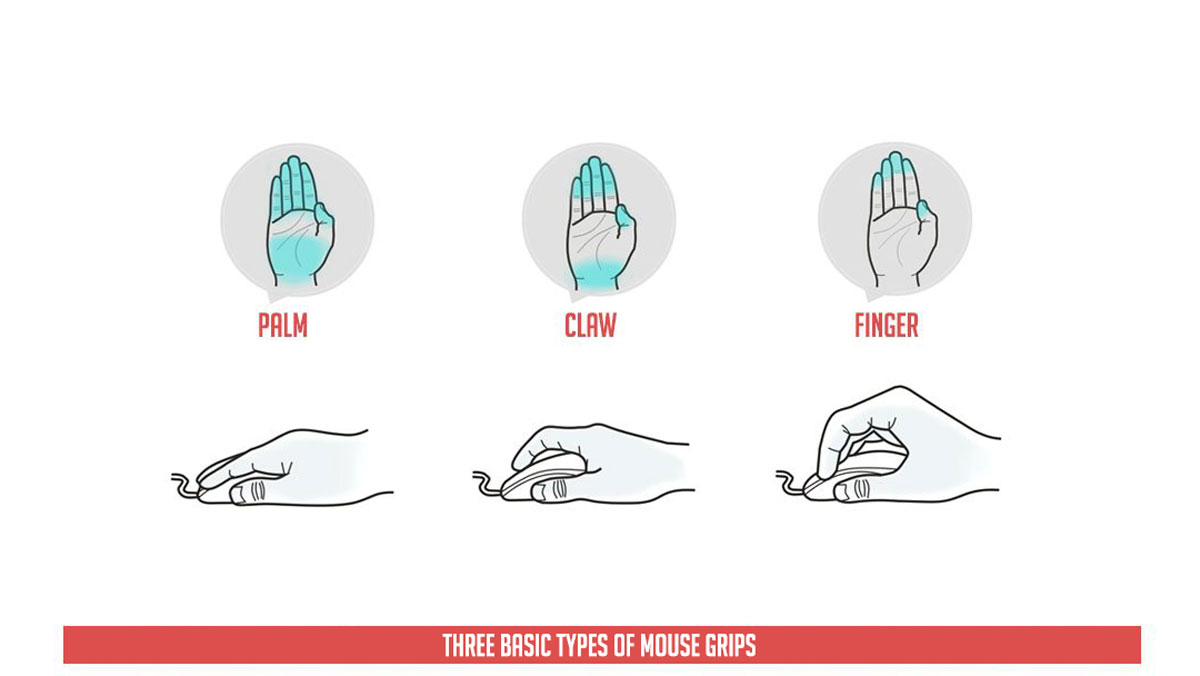
Your hand size also influences what mouse you should buy on top of your grip and aiming style. For an instance, my hands measures at 76.2mm (3″) in width. This puts my hands on the medium size category. My style is finger-tip grip, so I would generally look for a mouse with a small to medium foot print.
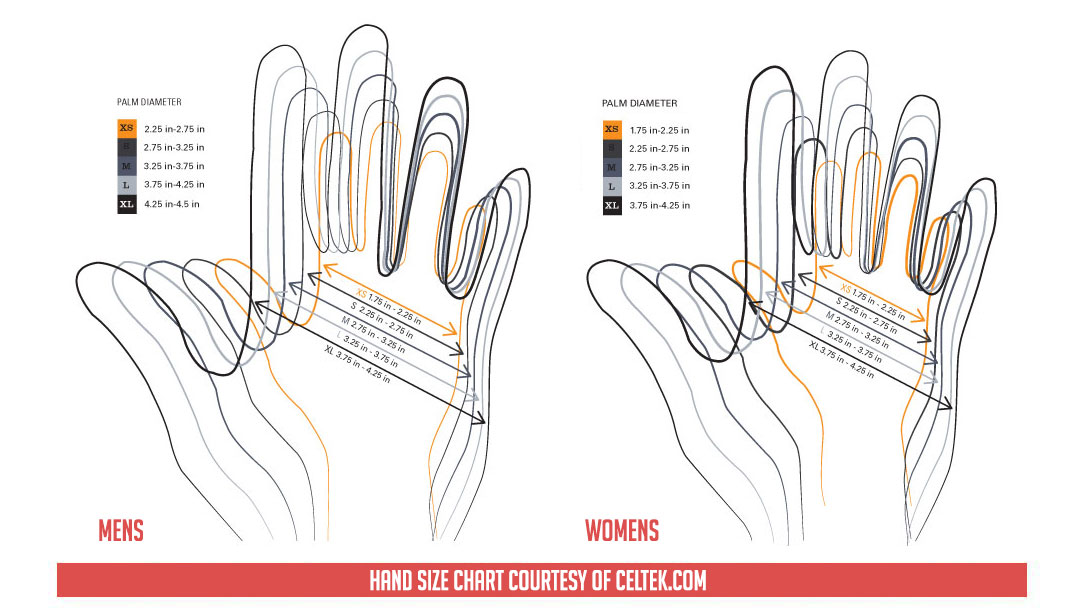
The ROG Keris feature a length of roughly 118mm and a grip area of about 55mm which is nice even if it is 62mm on the sheet. The highest point of the shell is at 39mm with a bit of bias towards the rear and a more obvious bias towards the left side.
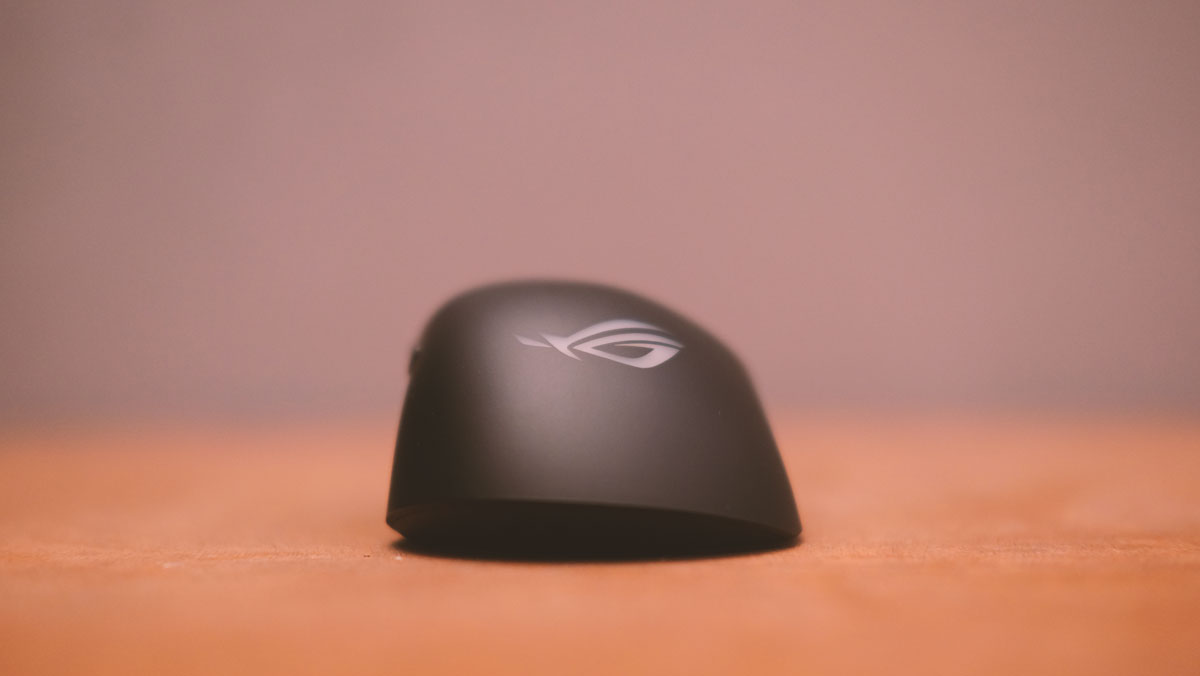
| Product | Length (mm) | Width (mm) | Height (mm) | Weight (g) |
|---|---|---|---|---|
| ASUS ROG Keris Wireless | 118 | 62 (55) | 39 | 79 |
| Fantech HELIOS XD3 PRO Wireless | 120 | 58 | 38 | 83 |
| ASUS ROG Strix Impact II Wireless | 120 | 62 | 38.6 | 93 |
| ASUS ROG Strix Carry | 101 | 62 | 36 | 72.9 |
| ASUS ROG Chakram | 132.7 | 76.6 | 42.8 | 121.6 |
| Galax Xanova Mensa Pro | 115 | 168 | 39 | 126 |
| ASUS ROG Gladius II Wireless | 126 | 67 | 45 | 130 |
| ASUS ROG Strix Evolve | 125 | 65 | 41 | 100 |
| Thermaltake Nemesis Switch | 111 | 88.5 | 38.9 | 112 |
| ADATA XPG Infarex M20 | 132 | 69 | 43.5 | 160 |
| HyperX Pulsefire FPS | 127.6 | 71.1 | 41.9 | 95 |
| Logitech G603 | 124 | 68 | 43 | 88.9 |
Weight is again ~79 grams which is one of the lightest wireless gaming mice that I have tested. While its shape and dimensions suggests that it is a medium sized mouse, the Keris felt more like something that’s in between small and medium’s territory.

| Product | Palm | Claw | Finger |
| ASUS ROG Keris Wireless | SML | SML | SML |
| Fantech HELIOS XD3 PRO Wireless | SML | SML | SML |
| ASUS ROG Strix Impact II Wireless | SML | SML | SML |
| ASUS ROG Strix Carry | SM | SM | SM |
| ASUS ROG Chakram | ML | ML | ML |
| Galax Xanova Mensa Pro | SML | SML | SML |
| ASUS ROG Gladius II Wireless | SML | SML | SML |
| ASUS ROG Strix Evolve | SML | SML | SML |
| Thermaltake Nemesis Switch | ML | ML | ML |
| ADATA XPG Infarex M20 | ML | ML | ML |
| HyperX Pulsefire FPS | ML | ML | ML |
| Logitech G603 | SML | SML | SML |
The ASUS ROG Keris Wireless is perfectly suitable for the three basic grip styles even if you have small, medium or large hands. This is one of the best ROG mice that I have tested in recent times – perhaps the best yet.

The mouse is also perfect for arm aiming and is planted enough for extended arm swipes. I thought I’ll have a harder time swiping left to right due to the hump’s left side bias but I was wrong. You just have to get used to it if you’re coming from an ambidextrous piece.
DPI Range and Accuracy
DPI accuracy is checked with the MouseTester V1.5.3 while the mouse is rigged on a camera slider with a DPI level of 800 DPI. Anything under 3% is considered accurate.
| Product | Min DPI | Max DPI | DPI Accuracy |
|---|---|---|---|
| ASUS ROG Keris Wireless | 100 | 1600 | 1.3% |
| Fantech HELIOS XD3 PRO Wireless | 100 | 16000 | 1.3% |
| ASUS ROG Strix Impact II Wireless | 100 | 16000 | 1.1% |
| ASUS ROG Strix Carry | 50 | 7200 | 1.2% |
| ASUS ROG Chakram | 100 | 16000 | 1.6% |
| Galax Xanova Mensa Pro | 50 | 16000 | 1.4% |
| ASUS ROG Gladius II Wireless | 100 | 16000 | 1.5% |
| ASUS ROG Strix Evolve | 50 | 7200 | 1.5% |
| Thermaltake Nemesis Switch | 400 | 12000 | 1.1% |
| ADATA XPG Infarex M20 | 400 | 5000 | 1.1% |
| HyperX Pulsefire FPS | 200 | 16000 | 1.1% |
| Logitech G603 | 200 | 12000 | 1.6% |
DPI at the standard ranges are accurately represented. Nothing wrong here.
Polling Rate Range and Performance
Polling Rate of the device is evaluated with the MouseTester V1.5.3 at the 800 DPI level. This is to check the average update rate performance at 1000Hz if possible.
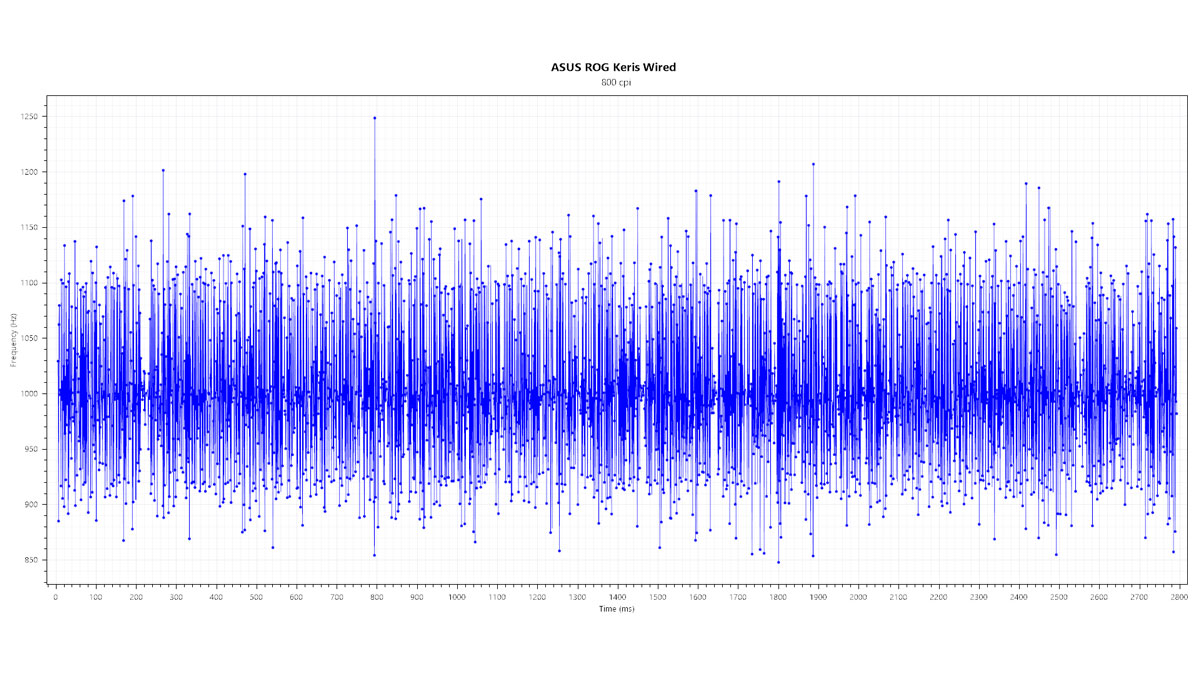
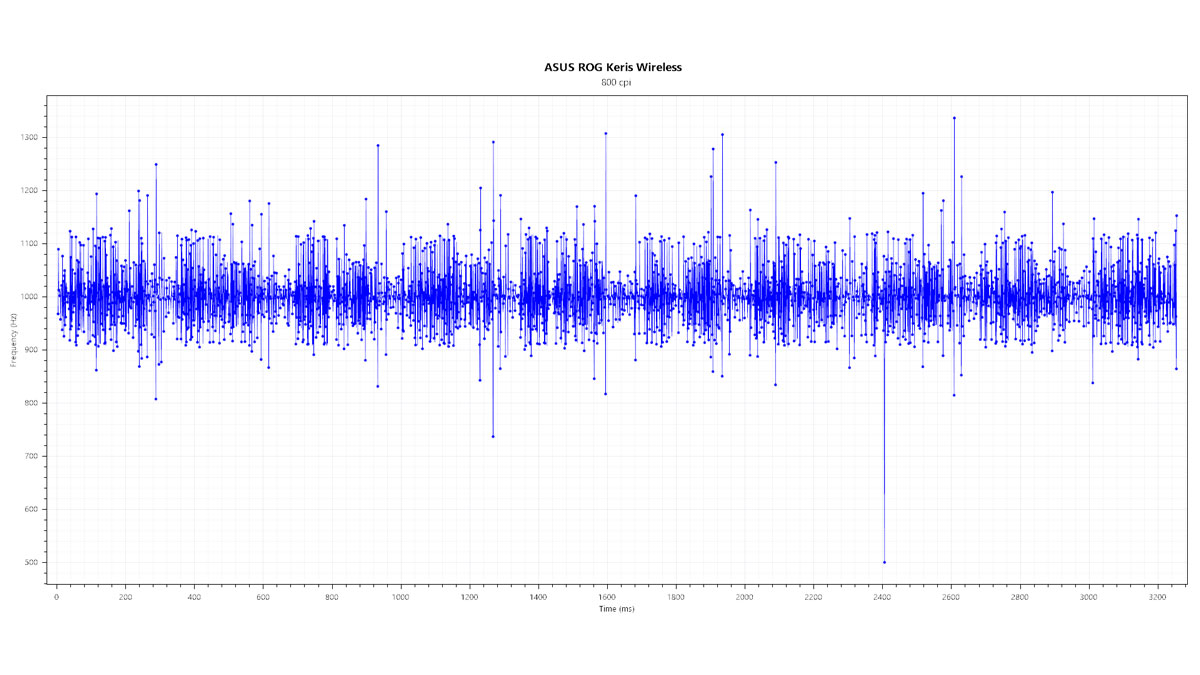
| Product | Min Polling (Hz) | Max Polling (Hz) | Performance |
|---|---|---|---|
| ASUS ROG Keris Wireless | 125 | 1000 | Good |
| Fantech HELIOS XD3 PRO Wireless | 125 | 1000 | Average |
| ASUS ROG Strix Impact II Wireless | 125 | 1000 | Average |
| ASUS ROG Strix Carry | 125 | 1000 | Average |
| ASUS ROG Chakram | 125 | 1000 | Average |
| Galax Xanova Mensa Pro | 125 | 1000 | Good |
| ASUS ROG Gladius II Wireless | 125 | 1000 | Good |
| ASUS ROG Strix Evolve | 125 | 1000 | Average |
| Thermaltake Nemesis Switch | 125 | 2000 | Average |
| ADATA XPG Infarex M20 | 125 | 1000 | Average |
| HyperX Pulsefire FPS | 1000 | 1000 | Great |
| Logitech G603 | 125 | 1000 | Great |
Polling performance is good for both the wired and wireless tests. A bit better in consistency compared to the other PAW3335 devices that I have tested due to better lower reports.
Sensor Quality and Performance
With a sensitivity of 800 DPI, the sensor is also checked with the MouseTester V1.5.3. Our aim is to check out the sensor’s performance – to look for reporting inconsistencies such as smoothing and unintended acceleration. The sensor quality is also taken into account based on its specifications and the general public opinion.
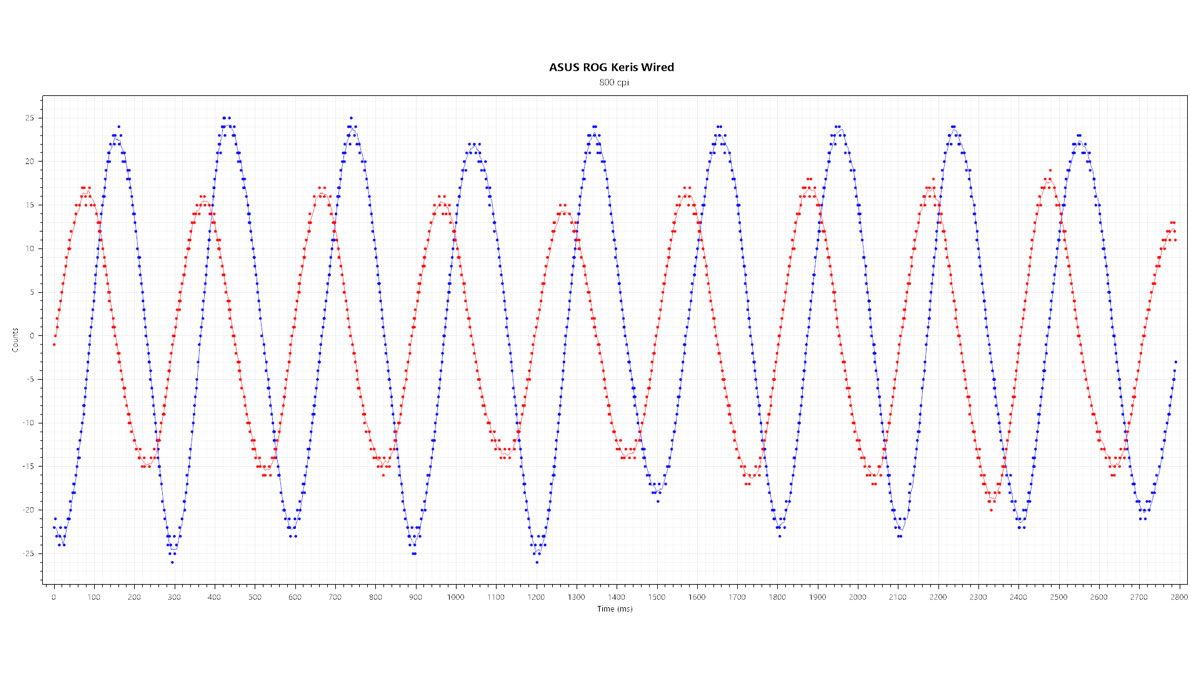
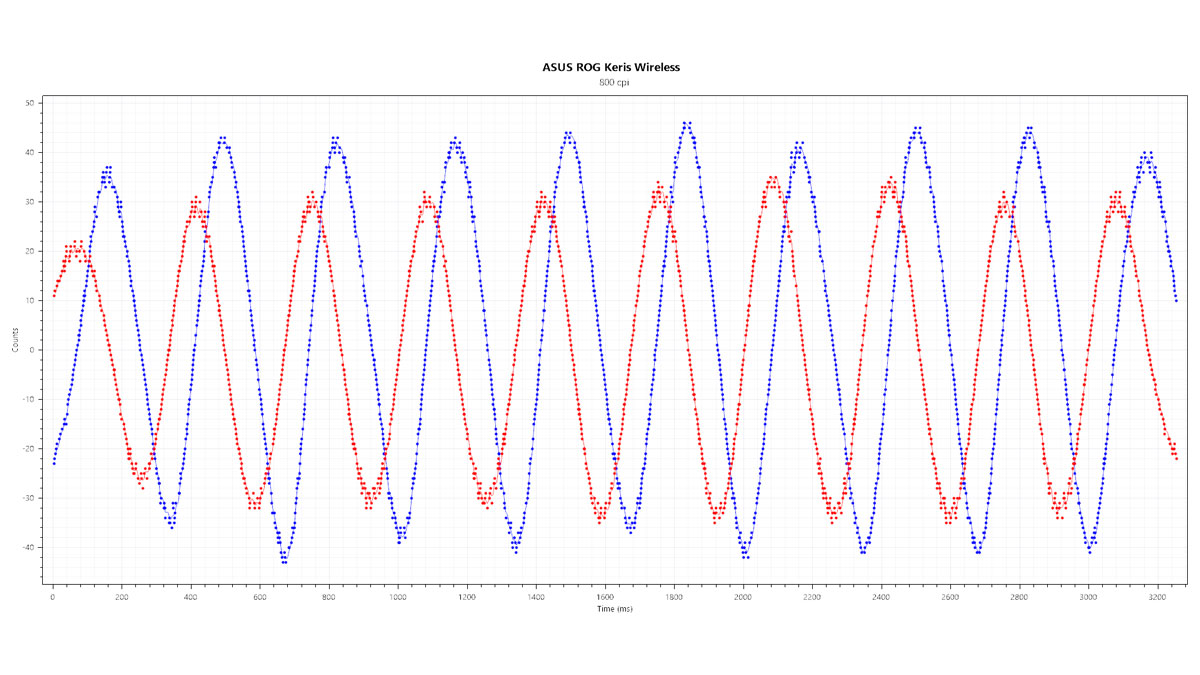
| Product | Sensor | IPS/G | LOD (mm) | Performance |
|---|---|---|---|---|
| ASUS ROG Keris Wireless | PAW3335 | 400/40 | 1-2 | Great |
| Fantech HELIOS XD3 PRO Wireless | PAW3335 | 400/20 | 1.5 | Average |
| ASUS ROG Strix Impact II Wireless | PAW3335 | 400/40 | 1-2 | Average |
| ASUS ROG Strix Carry | PMW3330 | 150/30 | 1.2 | Good |
| ASUS ROG Chakram | PWM3360 | 400/40 | 1.2 | Average |
| Galax Xanova Mensa Pro | PMW3389 | 400/50 | 1.2 | Good |
| ASUS ROG Gladius II Wireless | PMW3389 | 400/50 | 1.2 | Good |
| ASUS ROG Strix Evolve | PMW3330 | 150/30 | 1 | Good |
| Thermaltake Nemesis Switch | PWM3360 | 250/40 | 1 | Good |
| ADATA XPG Infarex M20 | PMW3325 | 100/20 | 1.2 | Great |
| HyperX Pulsefire FPS | PWM3310 | 130/20 | 1.2 | Great |
| Logitech G603 | HERO | 400/40 | 1.2 | Great |
Overall sensor performance is excellent – maybe even near perfect due to its much more consistent wired performance. Both the X and Y axis counts we got here are just awesome for both connectivity options.
Software, Lighting and Special Features
The ROG Keris Wireless comes with support for the ASUS Armoury Crate software. There are 6 sub menus here, starting with the Buttons menu. This one allows you to create macros, swap buttons, bind keyboard buttons, windows functions and add application shortcuts. This software is a must to get the most out of the mouse.
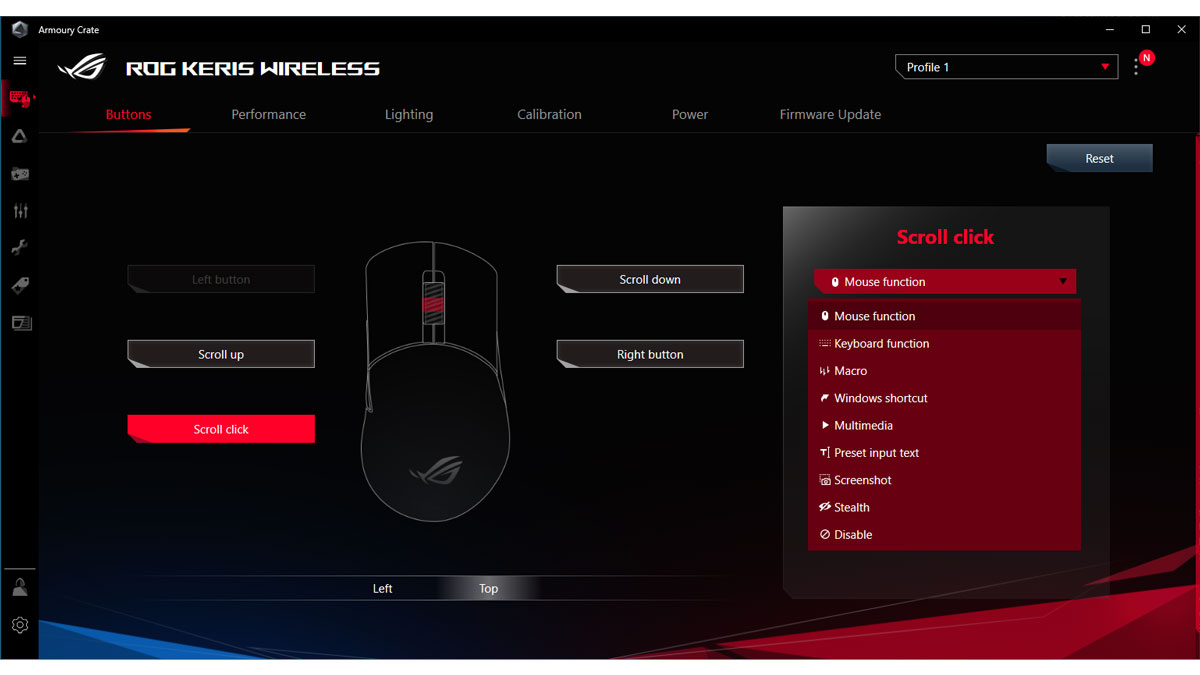
The Performance menu is where you could change the DPI presets along with the option to change the polling rate, button response and enable angle snapping. You could set profiles here to fit your needs. For example, a low power profile with 125Hz polling could be made if you do not wish to pair this in Bluetooth mode for energy saving.
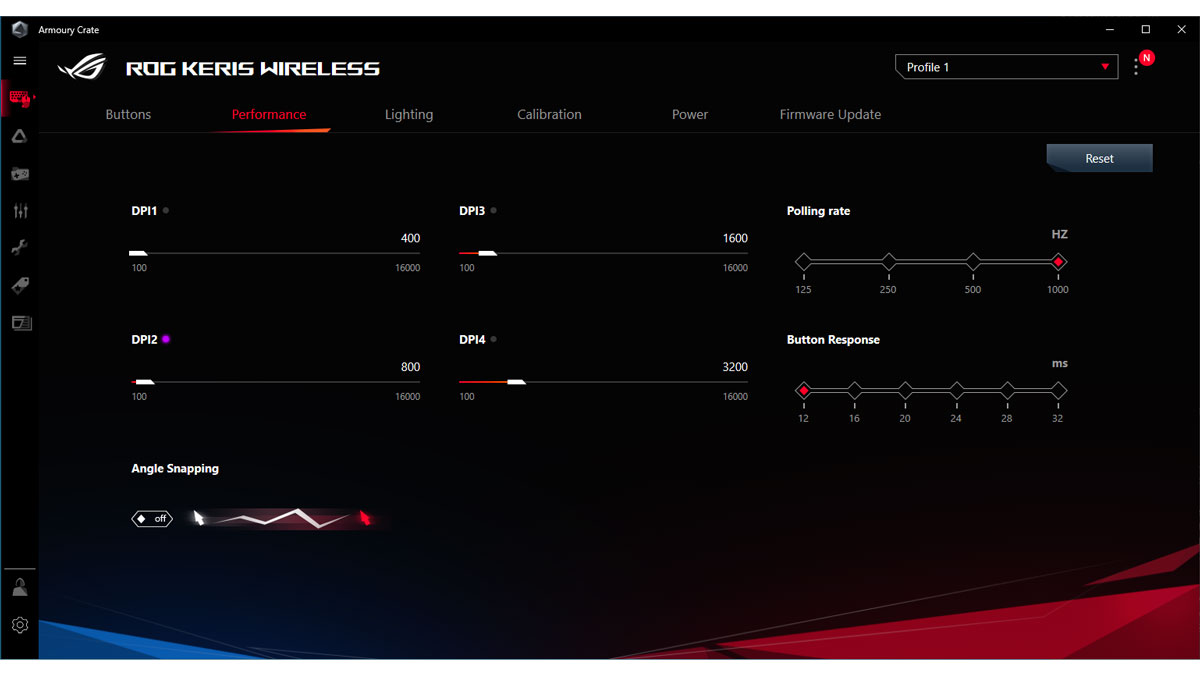
Lighting is up next. We have basic effects here that could be optimized as well. I’m not a fan of RGB lighting so you’ll have to visit the product page for more details about these effects. I like the addition of battery mode though. Of course, the Keris is also ASUS AURA Sync compatible.
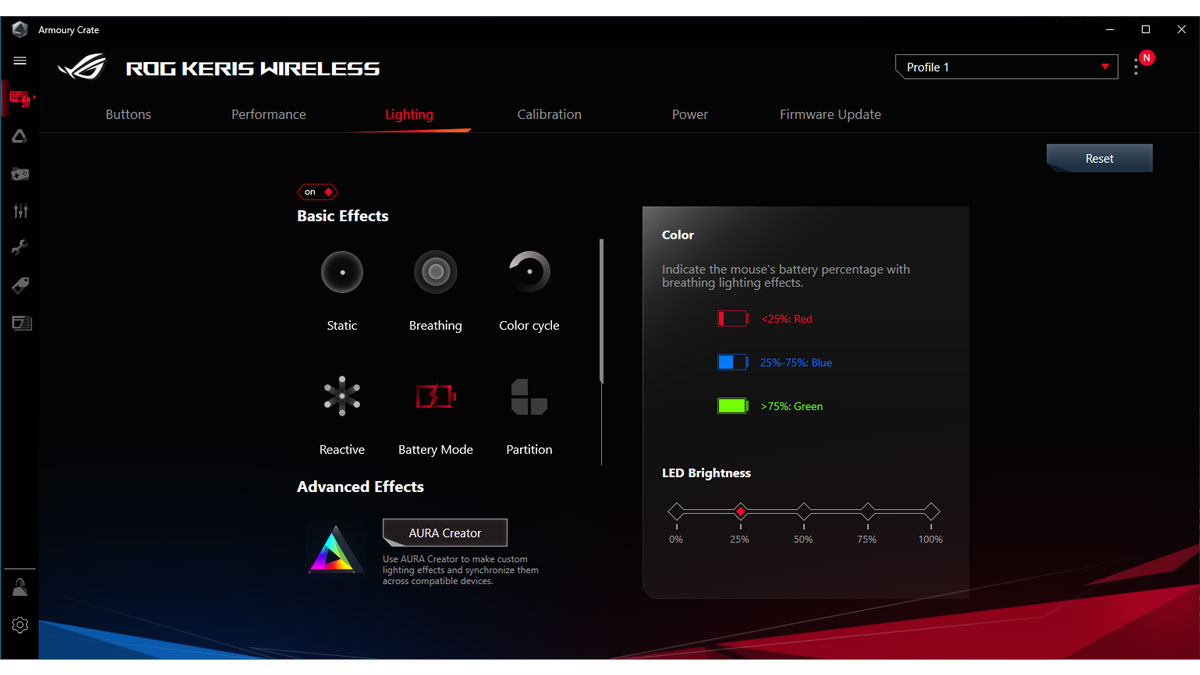
If you are looking for the LOD, it is located on the Calibration menu. No surface calibration here which is a bummer. Just the LOD adjustment itself with two options – Low and High. That’s 1mm and 2mm Lift Off Distance options.
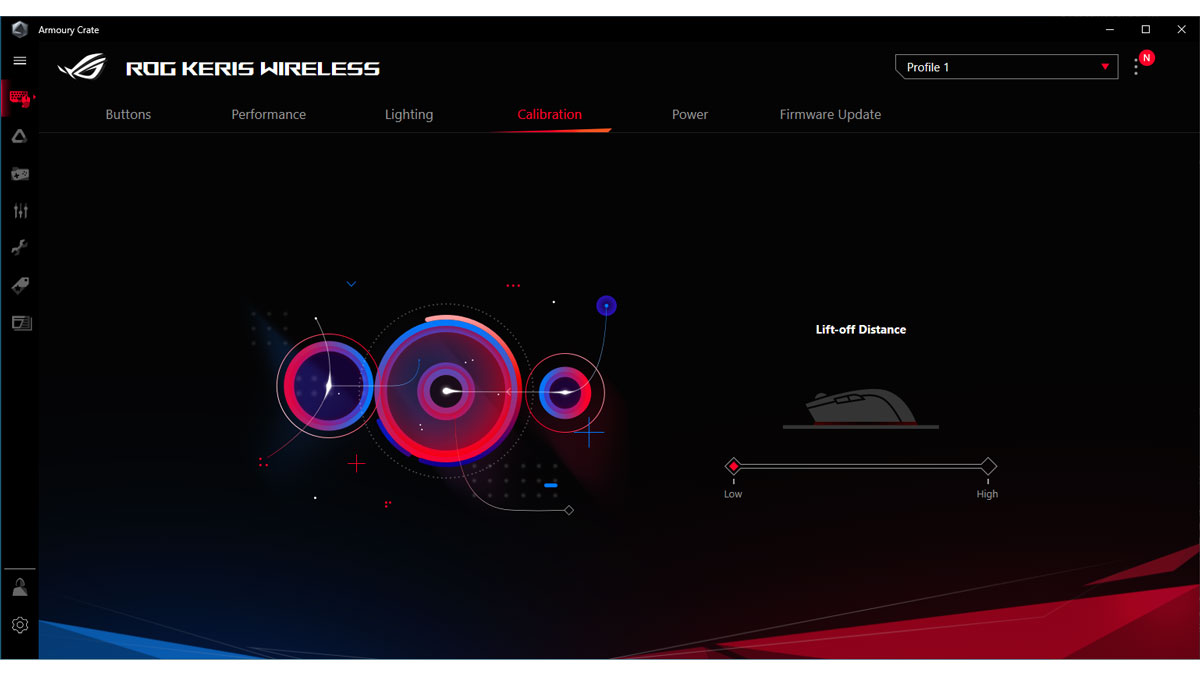
Power is where you could check your device’s battery capacity. You may even set the sleep mode here. 3 minutes works best for my usage – similar to my setup with the ROG Impact II and Strix Carry.
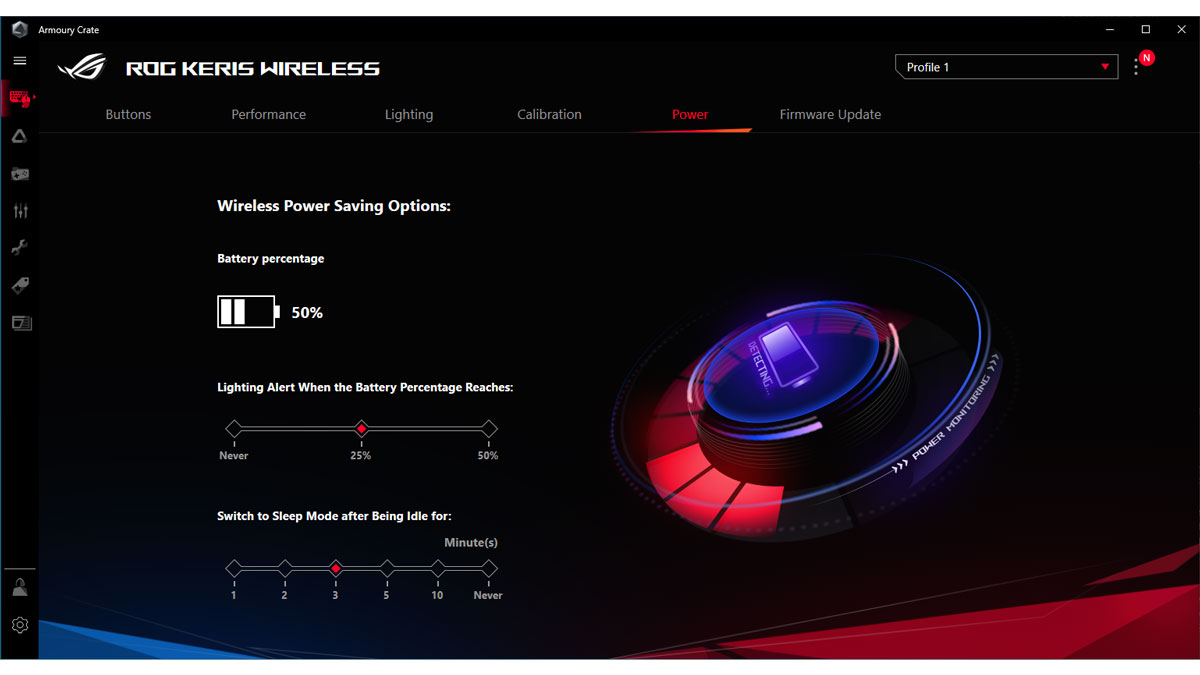
Lighting effects are excellent. ASUS even used a funnel for the Logo’s LED. Without it, the mouse could be even lighter.
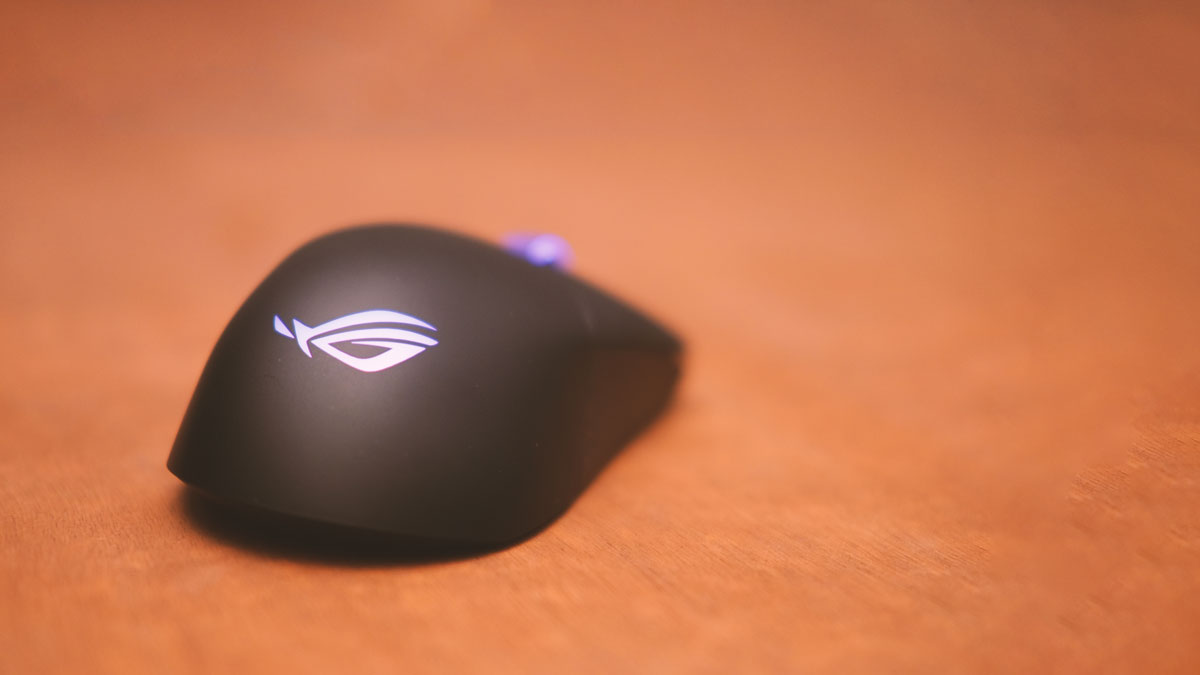
Now it is worthy to mention yet again that the ROG Keris comes with spare yet useful bundles. That includes the extra set of skates and the USB Type-C data and charging cable covered by a paracord. There are also extra side buttons to suite your theme. Of course, there’s an extra switch over the default ROG Micro Switches.
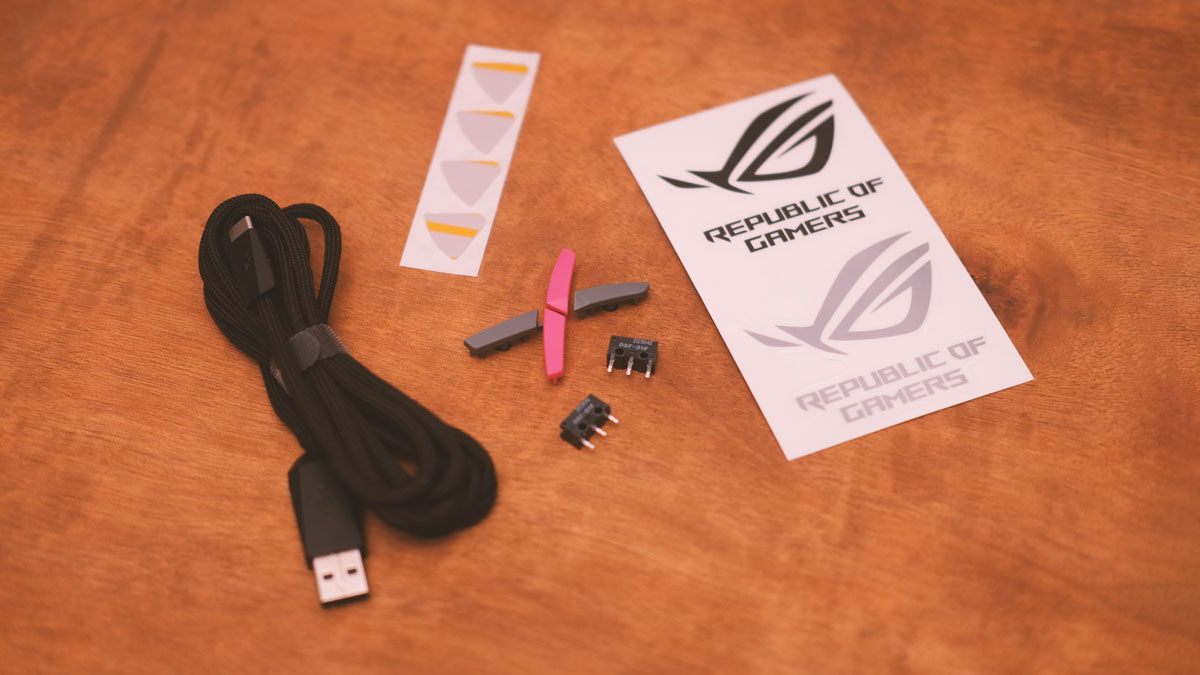
Removing the top shell requires you to pop two rubber covers and screws. Once removed, you could change the side buttons, switches and clean the mouse – perfect for cleaning a dirty scroll wheel. The battery is also removable – 500mAh is the default capacity so if you fancy going the DIY route, you could easily replace this one.
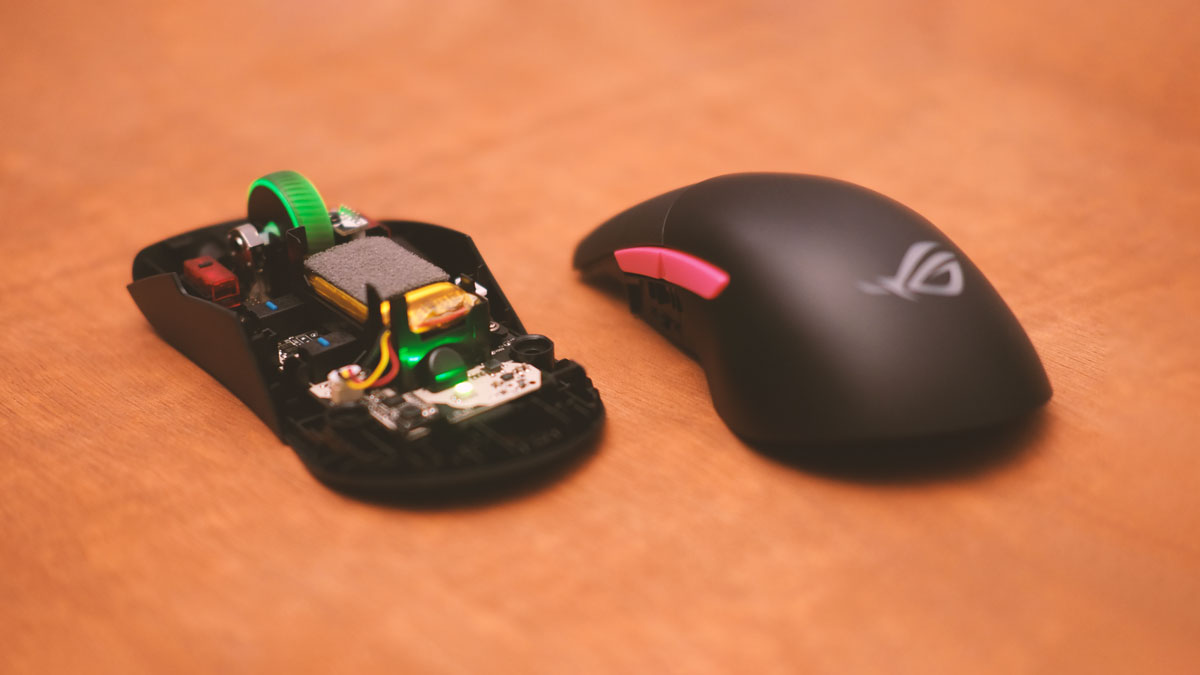
Battery life is yet to be determined. I’m pass 50 hours of use and it is still within the 25% level. For something with a 500mAh inside I initially considered this a blasphemy. Wireless range is great too as the mouse works well at distances and even obstacles – I.E., with an obstructed line of sight.
Final Thoughts
The ASUS ROG Keris Wireless is an excellent gaming mouse – both wireless and wired. This is what I have been waiting for ever since ASUS announced it – along with its features.
At first I was skeptical – having seen what the PAW3335 offered on previous reviews. This mouse completely changed that. After all, a well implemented hardware is better than a great hardware yet poorly implemented one.
What could’ve been done better? Nothing much really. Maybe a larger battery life, a full PBT housing or a white version? I dunno… Where it stands right now is perfectly fine. I hated onboard batteries before – just so yah guys know.
Priced at around 4,690 Pesos, the ASUS ROG Keris Wireless is a beast of a gaming mouse. It is comfortable, easy to maintain, has the performance to back it up and is just appropriate for its price point with everything else considered.
Note: The ROG Keris is also available in wired version at 3,380 Pesos.

ASUS ROG Keris Wireless
-
Performance - 9/10
9/10
-
Build Quality - 10/10
10/10
-
Features - 9/10
9/10
-
Design - 10/10
10/10
-
Value - 9/10
9/10
Summary
Priced at around 4,690 Pesos, the ASUS ROG Keris Wireless is a beast of a gaming mouse. It is comfortable, easy to maintain, has the performance to back it up and is just appropriate for its price point with everything else considered.
Pros
- PBT main button housing
- Excellent build quality and design
- Removable switches
- Easy to maintain
- Excellent bundles
- 2 meter long paracord Type-C cable
- Wired and Wireless performance + BT support
- Great price point – especially the wired version
- 79 gram – no holes needed
Cons
- Polling could be a bit more consistent
- Zero surface calibration option

